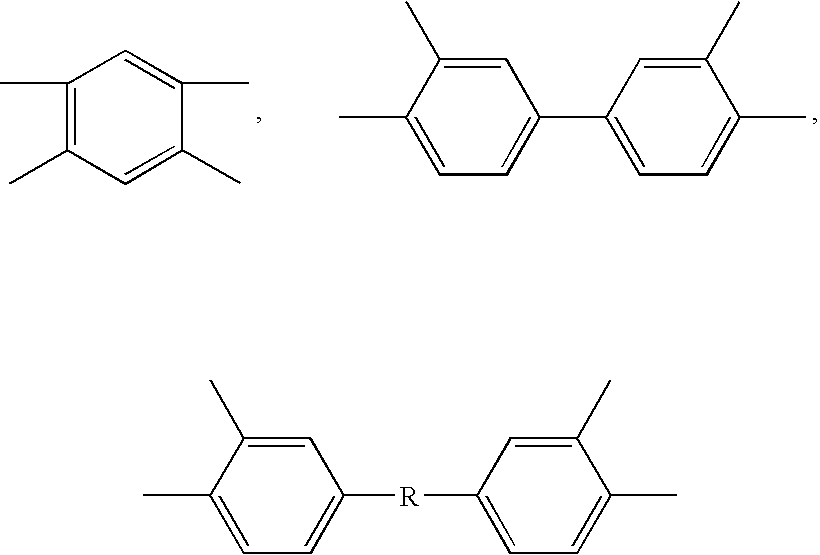Polybenzoxazole Membranes Prepared From Aromatic Polyamide Membranes
- Summary
- Abstract
- Description
- Claims
- Application Information
AI Technical Summary
Benefits of technology
Problems solved by technology
Method used
Image
Examples
example 1
Synthesis of aromatic poly(o-hydroxy amide) from 2,2-bis(3-amino-4-hydroxyphenyl)-hexafluoropropane (APAF) and 4,4′-oxydibenzoyl chloride (ODBC) (abbreviated as PA(APAF-ODBC))
[0053]An aromatic poly(o-hydroxy amide) (abbreviated herein as PA(APAF-ODBC) containing pendent —OH functional groups ortho to the amide nitrogen in the polymer backbone was synthesized by polycondensation of 2,2-bis(3-amino-4-hydroxyphenyl)-hexafluoropropane (APAF) with 4,4′-oxydibenzoyl chloride (ODBC) in NMP polar solvent by a one-step process. Anhydrous lithium chloride (LiCl) was used as the catalyst for the polycondensation reaction. For example, a 250 mL three-neck round-bottom flask equipped with a nitrogen inlet and a mechanical stirrer was charged with 8.0 g of LiCl, 7.32 g of APAF and 100 mL of NMP. Once the APAF was fully dissolved, a solution of ODBC (5.9 g) in 50 mL of NMP was added dropwise to the APAF solution in the flask under mechanical stirring at between −15° and 0° C. The reaction mixture ...
example 2
Preparation of PA(APAF-ODBC) Polymer Membrane
[0054]The PA(APAF-ODBC) polymer membrane was prepared as follows: 7.5 g of PA(APAF-ODBC) poly(o-hydroxy amide) synthesized in Example 1 was dissolved in a solvent mixture of 10.0 g of NMP and 5.0 g of 1,3-dioxolane. The mixture was mechanically stirred for 2 hours to form a homogeneous casting dope. The resulting homogeneous casting dope was allowed to degas overnight. The PA(APAF-ODBC) polymer membrane was prepared from the bubble free casting dope on a clean glass plate using a doctor knife with a 20-mil gap. The membrane together with the glass plate was then put into a vacuum oven. The solvents were removed by slowly increasing the vacuum and the temperature of the vacuum oven. Finally, the membrane was dried at 150° C. under vacuum for at least 48 hours to completely remove the residual solvents to form PA(APAF-ODBC) polymer membrane.
example 3
Preparation of Polybenzoxazole Polymer Membrane from PA(APAF-ODBC) Polymer Membrane at 350° C. (Abbreviated as PBO(APAF-ODBC-350C))
[0055]The polybenzoxazole polymer membrane PBO(APAF-ODBC-350C) was prepared by thermally heating the PA(APAF-ODBC) polymer membrane prepared in Example 2 from 50° to 350° C. at a heating rate of 3° C. / min under N2 flow. The membrane was held for 1 hour at 350° C. and then cooled down to 50° C. at a heating rate of 3° C. / min under N2 flow.
PUM
| Property | Measurement | Unit |
|---|---|---|
| Temperature | aaaaa | aaaaa |
| Angle | aaaaa | aaaaa |
| Temperature | aaaaa | aaaaa |
Abstract
Description
Claims
Application Information
 Login to View More
Login to View More - R&D
- Intellectual Property
- Life Sciences
- Materials
- Tech Scout
- Unparalleled Data Quality
- Higher Quality Content
- 60% Fewer Hallucinations
Browse by: Latest US Patents, China's latest patents, Technical Efficacy Thesaurus, Application Domain, Technology Topic, Popular Technical Reports.
© 2025 PatSnap. All rights reserved.Legal|Privacy policy|Modern Slavery Act Transparency Statement|Sitemap|About US| Contact US: help@patsnap.com



